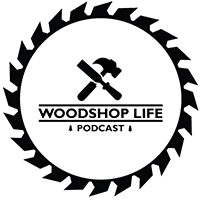Support us on Patreon: https://www.patreon.com/woodshoplife
Sean
1)Hi,
I want to start using SketchUp and wondering if you guys had any tips on coming up to speed with the app? Did any of you take any training or know of some good video series?
I’m fairly tech savvy, will be using Windows PC and Android devices.
Thank you for your down to earth, real world views! By far the best podcast out there!
Eric
2)Hello again, hope all is well. Perhaps this is somewhat of a tool true woodworkers would never use ,but I’ve always thought CNC machines are really cool and have always wanted to get one in my shop eventually to make custom signs, jigs, gifts and whatever more intricately detailed thing I couldn’t do by hand. Have you guys ever used a CNC machine for anything at any point, or maybe more importantly, WOULD you ever use one? Why or why not? Keep up the great work with the podcast – Brendon.
Guy
1)Hey guys, I’m working on building table tops for 4 or 5 pieces of living room furniture. I wanted to know if I should install something underneath the tops of the Coffee and console tables like 2 metal U channels to keep the tops flat? The coffee top will be about 4ft x 2ft and console top 2ft x 5 or 6ft. I’m using various hardwoods cut into long strips with different widths like a cutting board. My plan at the moment for the coffee top is to glue it up in 2 halves and use dowels to join the two. Also planning to use Z clips to secure the tops to the bases. Thanks for sharing your experiences with us,
Matt in Alabama
2)I’ve tried making finger joints/box joints. I’ve bought the flat grind blades and used the common technique of making groove in a sled and then shifting the pieces over into the slot/shim that I’ve created. It starts out fine for boards less than 4”, but for boards greater than 4”, I can’t get them to fit just right. Either they won’t join together or they’re too loose. What am I doing wrong? I don’t want to have to remake the sled/jig, but will do so if it means I can get boards of any size to fit properly together? How do you guys go about making box joints?
ChrisCustomWoodworks
Huy
1)I know it’s best to plane, joint etc. with the grain (rubbing the cat from head to tail instead of tail to head). I have trouble determining which direction the grain is running. Any foolproof pointers?
Thanks for the best woodworking podcast around!
Great podcast – thanks for all the information! – Tim in North Carolina
2)Hi Guys from across the pond in the Uk! Love the podcast, the time in the shop is more enjoyable when I’m listening to you guys laugh and chat about your woodworking knowledge, it’s a great help and has answered so many of my questions already. I wanted to ask your advice on shaker cabinet doors. I make a lot of shaker doors for cabinets, alcove units and fitted wardrobes. The problem comes when painting. I don’t spray anything and use water based finishes. I use a water based wood primer undercoat and then a acrylic eggshell topcoat. I lay the doors flat and level on my bench, as soon as the first coat of undercoat goes on the door bows badly, it bows with the centre going away from you on the painted side. After about half an hour the undercoat has gone off enough for me to flip the door and paint the other side which then flattens the door back out but it sometimes doesn’t go back to what it should and also this just doesn’t feel great to me, with my straight edge the door is perfect after glue up/sanding but it’s never this good after painting. Any tips on what I could do/am missing when it comes to finishing these doors. Would love to hear from you guys and keep up the good work, love the show and keep producing great work!
Thanks
Mike @mgscarpentry
